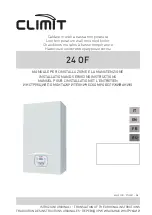
28
Appendix 1.
A Guide to Positioning Steam Pipes:
Notes:
1
Steam pipe to have a minimum slope from
the horizontal of 7° or 12% to allow the
condensate to drain back to the cylinder or
trap.
NO HORIZONTAL RUNS. NO 90°
ELBOWS.
2
Water condensate tube to slope at 10° or
18% from the horizontal for condensate to
drain back to drain point.
3
Steam pipes which are mounted
horizontally must discharge vertically
upward.
4
Vertically mounted Steam pipes must
discharge horizontally facing upstream
airflow.
5
If the total pressure within a duct air flow
exceeds 2000 Pa and the static is below
2000 Pa then the probe may face
horizontally at right angles to the air stream.
6
Care should be taken to support steam
hose sufficiently such that no kinks are
formed which would flood with condensate
causing the bore of the tube to become
constricted, leading to excessive pressure
in the steam lines.
N.B Standard steam distribution pipes are
manufactured such that any condensate is drained
back towards the Vapac steam cylinder. Reverse
slope pipes are available, and are fitted with a drain
connector, to enable condensate to be taken away to
a suitable drain.
min
300mm
R
B
L
H
min 20mm
L
B
H
min 20mm
B
L
R
min 20mm
X
Y
Y
X
min 20mm
AIR
FLOW
FLOW
AIR
FLOW
AIR
See Note 1
See Note 1
See Note 1
See Note 1
See Note 1
See Note 1
See Note 2
See Note 1
See Note 2
X = 60 minimum height
negative pressure
1
3
3
See Note 2
2
2
2
for a maximum
-600 Pa.
Y = 220 minimum height
2000 Pa.
positive pressure
for a maximum
Vapac Humidity Control Ltd. Issue this as a guide only, and accept no responsibility for
the positioning of any pipes in a system. This remains the responsibility of the Project
Design Engineer.
Key;
1 Insulated
Steam
Hose
2
Steam Distributor Pipe
3 Hose
Clip
4
Condensate Separator.
Fig 1
R = 250 minimum
radius for 35 Ø pipe.
R = 500 minimum
radius for 54 Ø pipe
.




































